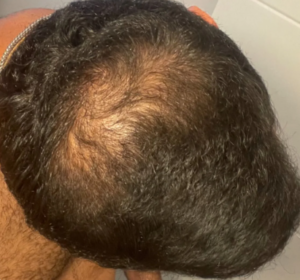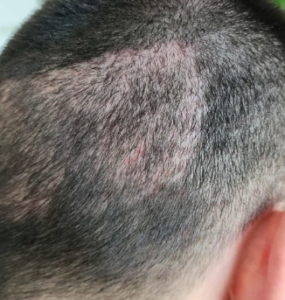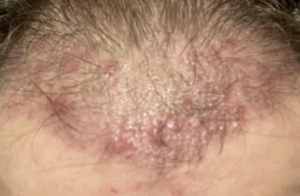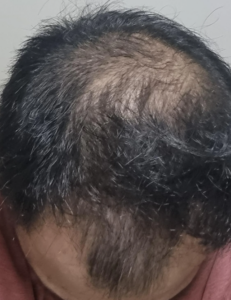The donor hair thickness’s value will dictate the graft quality and quantity you need. Men with coarser hair require fewer grafts and get better results than men with fine hair who require more grafts; even with more grafts, the difference between the results is significantly different. In Turkey, most of the clinics (not physician-run nor driven by such factors that I mentioned above) do not do this analysis but deplete your donor area regardless of your needs.
This is a widespread error for surgeons performing a hair transplant. Hair is often placed like the spokes of a bicycle, circularly. In this particular man, the mistake was for half of his right hairline; however, I often see the entire hairline created this way. When a man has straight hair, such errors create a freaky look. See where half of the right frontal hairline points in the wrong direction. I drew straight lines in the photo to show the error.
I’m 21 and I want to get a hair transplant. My Norwood class of balding is a Class 3. I met with one doctor who wanted to do 4000 grafts on me. What do you think?
At 21, you should not do any hair transplants. Your balding pattern will not be clear, and the use of your donor supply by sloppy doctors may deplete your donor supply before knowing where your balding is going. Get a Personalized Master Plan from a good hair doctor, first and foremost. Too many Class 3 and 4 patients get megasessions and eat up their donor supply before they complete their balding process. Being deformed from bad planning for the rest of your life is not a good thing!
You appear to be a good candidate, assuming that you have already tried some of the other non-surgical treatments and that they have failed. Do you have miniaturization on your scalp beyond the hairline area? Ask your surgeon about your baseline donor density and hair mass (donor hair thickness). These two factors will allow you and your surgeon to predict how you will manage if you continue to lose more hair (likely). If your surgeon can’t answer these questions, could you find another surgeon who will? You must remember that the surgeon works for you, and as such, in a job interview (you being the interviewer), you need to ask the right questions and expect reasonable answers. If the surgeon gets upset with your questioning why he is offering you surgery, then get the hell out of there because you shouldn’t want to hire such a doctor. If you only meet with a salesman or saleslady, then run for the hills.
FYI: Juvenile hairlines are not uncommon. In Caucasians, they are less than 5% (e.g., Bill Clinton), while in India, they may reflect 25% of the male population. My Grandfather died at 102 with his 5-year-old hairline and black hair (no gray).
I am in the situation where I am quite good looking (sometimes get asked if i’m a model when wearing a hat), but genetically have a terrible hairline. My hairline has been like this as long as I can remember. It’s a problem that’s been bothering me greatly since I was 13 already, always wearing a “justin bieber hairstyle” to cover it up, being scared of wind, etc. Hair loss fairly minimal. Recently I decided to get a transplant and put down a deposit. Plan is to lower the hairline a bit, fill in temples, maybe temporal peaks (undecided). 2700 grafts planned for hairline and temporal peaks. However, I’m not totally sure if it’s worth it. The things I am worried about:
Lack of density in the transplanted hairline.
Botched/failed transplant (surgeon is quite reputable but you never know).
FUE scars on my head.
Transplanted hairs falling out /not growing properly.
Transplanted hairs falling out after 5+ years,
I have previous experience doing a rhinoplasty to straighten my broken nose from boxing and I’m not very happy with the result (although its not terrible). I know that reality and what people write on the internet can be very different from my own case, and I really regret doing that procedure. Is it actually possible that I will do the surgery and end up with a result I’m satisfied with, a lower hairline with nicely dense looking hair I can style in any way? Or is it more likely I’ll end up with an inferior result and be sprinkling toppik into my fake hairline
I would REALLY appreciate some answers as I’m quite on the fence. In case there’s a decent chance transplants are overhyped and likely end up semi-botched, I’d rather just stick with the hats than worry about covering up my transplant for the rest of my life. But in the case that I could simply do it and have a great result and go out with a normal hairstyle, that would be life-changing. So it’s a difficult decision for me. Thank you so much.
Are you balding? Is this a hairline recession? You can alleviate these concerns by getting a good, honest, competent surgeon to evaluate you. The questions you ask here should be asking of the surgeon. A good surgeon will measure your donor supply, donor density, and hair mass to set up your expectations. You need to know more about what your balding pattern might evolve into, assuming that you are in some stage of the balding process. A good examination by a surgeon will help guide you here. This is what I do and have done for 33 years, and I have done it on some of the wealthiest people in the world and many, many celebrities from Hollywood.
My shedding from starting finasteride is still happening 6 months since I started the drug. What should I do?
Drug-induced shedding usually stops in a month, rarely 2 months. See your doctor and find out what the cause of your shedding is as it may not be the drug but some acceleration of your hair loss.
When did you see results after using oral dutasteride and/or oral minoxidil
These drugs start working almost immediately. Remember that hairs that are miniaturized and benefit from these drugs have to grow from their base, a process that takes up to a month or so before they emerge from the scalp. If you plucked one of these hairs at, say, four months, you would see a wider shaft at the bottom (the new growth) and a smaller shaft on the upper part (the miniaturized component of the hair). Sometimes it takes up to 18 months to see the value from finasteride.
I would wait until all of the healing is complete on the recipient area. That would take 3 months.
Editorial comment from American Journal of Dermatology: Scalp pruritus affected 19% of participants in the topical minoxidil group. Pretibial edema occurred in 4% of participants in the oral minoxidil group. Hypertrichosis was more common with oral minoxidil (27% oral vs 4% topical), although this side effect was mild and well tolerated; 3 participants did not take any action to remove the excess hair, and 5 managed it with waxing. There was no difference between the groups regarding the variation of mean blood pressure over time. The mean heart rate at rest increased 6.5% in the oral minoxidil group without tachycardia; there was no change in the topical minoxidil group. No hypotension-related events occurred. No adverse events in oral minoxidil group required cessation of medication. Our results reveal that low-dose oral minoxidil provides improvement of FPHL that does not differ Table I. Main clinical and demographic data from participants Category Oral minoxidil 1 mg Topical minoxidil 5%……. Research Letters from topical minoxidil 5% solution, with a safe profile and well-tolerated adverse effects. The performance of oral minoxidil in regard to the Sinclair hair shedding score was superior to that of topical minoxidil, reinforcing the favorable results reported with telogen effluvium. The increase in total hair density lay within the topical minoxidil 95% CI; however, if the outcomes are taken together, they suggest a trend toward a greater improvement in the oral minoxidil group. Confirmation of this would require larger and longer studies. In conclusion, oral minoxidil can be considered an option for FPHL patients with poor compliance or who cannot tolerate topical minoxidil.
Doc, how many months would you say if I went on finasteride? Is it needed for a very miniaturized hair to return to its original thick shaft diameter? Thank you.
That varies between people and the aggressiveness of the balding process. In some men, I have seen plucked hairs indicate that the new growth occurred within a month
It is likely over-harvesting, but you must wait this out for 6 months as shock loss will usually reverse itself by then. Let your hair grow out to cover it up. You can use Toppik to cover the problem while it is short. If it doesn’t reverse, then SMP by a good operator will solve the problem. Be sure to view the work of the SMP clinic you find, as seeing is believing and you don’t want to become a victim again if it was overharvested.
I hope that this man didn’t go to Turkey to a clinic there that had no doctor. He needs to see a doctor, and many doctors don’t like to take responsibility for problems like severe folliculitis in recipient grafts if they don’t do the surgery themselves. These grafts will probably not grow in the long term, but if he doesn’t react rapidly to this infection, more grafts may die off, and worse, even he could develop a much more extensive infection. This has many causes, including men who scratch their itchy recipient areas or poor sterile conditions at the time of the transplant. There are many other causes, but these are two of the more prominent causes.
I’m a 44 y/o male, I’ve been told between 4000 in one session or +5000 in two sessions both in FUE, and also been told need FUT, but Im trying to avoid it. My question is if 4000 graphs in one session would suit me (3000 in front/top and 1000 in crown), considering I would be happy with a receding hairline, just not too receded, and I could have a SMP to improve a low density crown area. I’m based in Perth Australia, so I’m considering to get it done in Thailand, Philippines and also Turkiye.
Your frontal area (assuming you have an average hair weight) should take no more than 2000 grafts for a good look. More than that, doesn’t necessarily add value, might just waste your donor hair and put more money in your surgeon’s pocket. Your transplanted hairline should be receded, which is why you are doing it: to look normal. The crown should not be transplanted but instead treated with finasteride, as you have an excellent chance of reversing it. Too many doctors quote too many grafts for reasons that may be financial for them and not good for you.
Yesterday, we did SMP (Scalp Micpigmentation) on a patient whose hair transplant didn’t quite achieve the desired FULLNESS he nor I wanted to achieve. He reached his limit of grafts at about 4000 grafts but still wanted a full head of hair. He had a very large head and a poor donor density. I subsidized his 4000 donor area grafts with 500 beard grafts to the crown in the second of two procedures. This gave him just about enough hair to lightly cover the crown. With SMP, his situation has changed radically, as you can see with the before and after photos taken 4 hours into the SMP, which was still going as this post was written.
This is a wonderful approach when hair fullness (notice I didn’t use the term density) is not achieved. Density is just one element that contributes to the LOOK OF FULLNESS. Other aspects contributing to fullness include the color/contrast between hair and skin color (SMP addresses this very nicely, as shown in this photo below), the thickness of each hair follicle (this man had fine hair reflecting poor hair bulk), and the needs of the balding area (can be expressed in square inches of balding area compared to the donor supply). This man has a Class 7 balding pattern, where a 4:1 imbalance exists between the size of the bald area and the donor area (in his situation, less than half can be used). There is clearly a limit when the graft supply is exhausted.
The patient and I discussed this before the very first procedure, and he went into this with his eyes open because I developed a Personalized Master Plan for him as I started his reconstruction. His first procedure was designed to build a hairline and put enough hair in the frontal 5-6 inches to frame his face and give him some light top coverage. The transplant brought the coverage to mid-scalp. He had a fantastic result and he styled his hair to take advantage of combing it from left to right. The second procedure took it further back to the top and crown. I used beard hair mixed with some scalp hair for this area. In this last procedure 1 year ago, I included some beard hair for his bald crown. When all of this grew in, the back of his head was sparsely covered but with enough hair that a comb-over would suffice. The SMP is the topping to this process as it created the fullness that he desired.
I published an article in 2018 in the Journal of Plastic and Reconstructive Surgery on this philosophy. The theme of this article was that when combining FUE and SMP, the surgeon can almost transplant any healthy man, provided that the donor area is healthy. As this article has been read more often since it was initially published (I receive tracking of the reads), more and more surgeons are adopting this approach in planning a hair reconstruction on men with lower-than-ideal donor densities, fine hair, and advanced balding patterns. This approach requires an excellent team to back up the surgery, including perfection on the SMP side of the equation, as shown in the photo below.
 This photo was taken when only half of the head was done in the mid-point of the procedure.
This photo was taken when only half of the head was done in the mid-point of the procedure.
Page 16 of 1237









